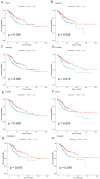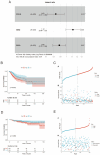Exploring MiR-484 Regulation by Polyalthia longifolia: A Promising Biomarker and Therapeutic Target in Cervical Cancer through Integrated Bioinformatics and an In Vitro Analysis
- PMID: 38672263
- PMCID: PMC11047986
- DOI: 10.3390/biomedicines12040909
Exploring MiR-484 Regulation by Polyalthia longifolia: A Promising Biomarker and Therapeutic Target in Cervical Cancer through Integrated Bioinformatics and an In Vitro Analysis
Abstract
Background: MiR-484, implicated in various carcinomas, holds promise as a prognostic marker, yet its relevance to cervical cancer (CC) remains unclear. Our prior study demonstrated the Polyalthia longifolia downregulation of miR-484, inhibiting HeLa cells. This study investigates miR-484's potential as a biomarker and therapeutic target in CC through integrated bioinformatics and an in vitro analysis.
Methods: MiR-484 levels were analyzed across cancers, including CC, from The Cancer Genome Atlas. The limma R package identified differentially expressed genes (DEGs) between high- and low-miR-484 CC cohorts. We assessed biological functions, tumor microenvironment (TME), immunotherapy, stemness, hypoxia, RNA methylation, and chemosensitivity differences. Prognostic genes relevant to miR-484 were identified through Cox regression and Kaplan-Meier analyses, and a prognostic model was captured via multivariate Cox regression. Single-cell RNA sequencing determined cell populations related to prognostic genes. qRT-PCR validated key genes, and the miR-484 effect on CC proliferation was assessed via an MTT assay.
Results: MiR-484 was upregulated in most tumors, including CC, with DEGs enriched in skin development, PI3K signaling, and immune processes. High miR-484 expression correlated with specific immune cell infiltration, hypoxia, and drug sensitivity. Prognostic genes identified were predominantly epidermal and stratified patients with CC into risk groups, with the low-risk group showing enhanced survival and immunotherapeutic responses. qRT-PCR confirmed FGFR3 upregulation in CC cells, and an miR-484 mimic reversed the P. longifolia inhibitory effect on HeLa proliferation.
Conclusion: MiR-484 plays a crucial role in the CC progression and prognosis, suggesting its potential as a biomarker for targeted therapy.
Keywords: cervical cancer; immunotherapy; miR-484; prognostic genes; proliferation.
Conflict of interest statement
The authors declare no conflicts of interest.
Figures












Similar articles
-
The significance of m6A RNA methylation modification in prognosis and tumor microenvironment immune infiltration of cervical cancer.Medicine (Baltimore). 2022 Jul 1;101(26):e29818. doi: 10.1097/MD.0000000000029818. Medicine (Baltimore). 2022. PMID: 35777046 Free PMC article.
-
FAM83A as a Potential Biological Marker Is Regulated by miR-206 to Promote Cervical Cancer Progression Through PI3K/AKT/mTOR Pathway.Front Med (Lausanne). 2020 Dec 4;7:608441. doi: 10.3389/fmed.2020.608441. eCollection 2020. Front Med (Lausanne). 2020. PMID: 33344485 Free PMC article.
-
A Novel Prognostic Risk Model for Cervical Cancer Based on Immune Checkpoint HLA-G-Driven Differentially Expressed Genes.Front Immunol. 2022 Jul 18;13:851622. doi: 10.3389/fimmu.2022.851622. eCollection 2022. Front Immunol. 2022. PMID: 35924232 Free PMC article.
-
The Landscape of the Tumor Microenvironment in Skin Cutaneous Melanoma Reveals a Prognostic and Immunotherapeutically Relevant Gene Signature.Front Cell Dev Biol. 2021 Oct 1;9:739594. doi: 10.3389/fcell.2021.739594. eCollection 2021. Front Cell Dev Biol. 2021. PMID: 34660598 Free PMC article.
-
Bioinformatics Analysis of Novel Targets for Treating Cervical Cancer by Immunotherapy Based on Immune Escape.Cancer Genomics Proteomics. 2023 Jul-Aug;20(4):383-397. doi: 10.21873/cgp.20390. Cancer Genomics Proteomics. 2023. PMID: 37400149 Free PMC article.
References
-
- Doghish A.S., Ali M.A., Elyan S.S., Elrebehy M.A., Mohamed H.H., Mansour R.M., Elgohary A., Ghanem A., Faraag A.H.I., Abdelmaksoud N.M., et al. miRNAs role in cervical cancer pathogenesis and targeted therapy: Signaling pathways interplay. Pathol. Res. Pract. 2023;244:154386. doi: 10.1016/j.prp.2023.154386. - DOI - PubMed
LinkOut - more resources
Full Text Sources

